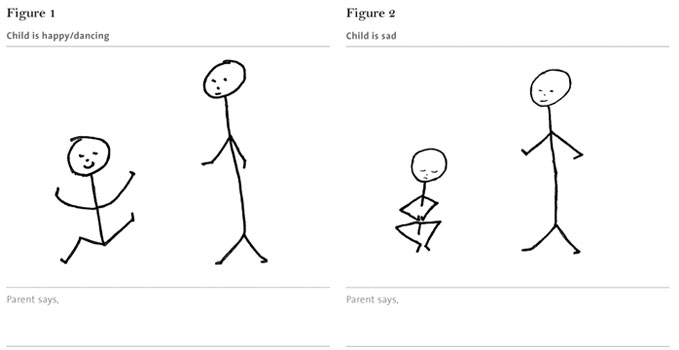Web-site restrictions
ACAT will be moving to a new web site on Thursday, 10th April.
In preparation, from Friday, 4th April this old web site will not let members renew their membership, and any other changes members make, e.g. their personal details, will get ‘lost in the move’.
Urgent membership renewals should instead be done by contacting Alison Marfell.
The Inner Voice Check
Elia, I., 2007. The Inner Voice Check. Reformulation, Summer, pp.28-29.
The Inner Voice Check (IVC) is a set of 10 (A4 size) line drawings, each showing a child and a parent.
The drawings are headed by a simple statement about the child e.g. ‘Child is happy/dancing.’ (see Fig. 1) or ‘Child is sad.’ (see Fig. 2). At the bottom of each drawing, there is a space for the client to complete the sentence: ‘Parent says, ......’ This gives the client an opportunity to express the ‘inner parent’ voice, which is sometimes the role that is hidden. For example, on the sheet headed ‘Child is furious’, one highly educated client filled in the ‘Parent says,’ phrase with ‘Screw you.’ and another completed the ‘Child is cross.’ with ‘Parent says, Let’s go to the cinema.’ [The ten headings are: ‘Child is happy/dancing’, ‘—is upset’, ‘—talking’, ‘—cross’, ‘—awed’, ‘—withdrawn’, ‘—sad’, ‘—furious’, ‘—confused’, ‘Child cannot do.’] I have included only two drawings here as examples. If people are interested, I will try to place all 10 on the ACAT website.
First offered to my co-supervisor as a potential outcome measure to use with teenage clients, I have been using it with most of my adult clients for approximately three years. I usually present it after reformulation, but for clients who are less communicative, I may offer it in session 3, after the CORE and Psychotherapy File have been completed and discussed in previous sessions.
IVC has also been used for people with learning disabilities (PLD), and it was for this application that the last three drawings (not shown here) were created:
‘Child is furious.’
‘Child is confused.’
‘Child cannot do.’
Although these three were suggested by and specifically drawn at the request of a clinical psychologist working with PLD, I give all 10 drawings to my clients.
Responses from PLD, which can be tape-recorded or written down by the psychologist/therapist, are similar to and as revealing as those from non-learning disabled adults. Here are some responses from both groups; can you tell which come from which? (‘Answers’ are at the end.)
- ‘ Child is happy/dancing.’ ‘Parent says, Stop messing around I’m busy.’
- ‘ Child is cross.’ ‘Parent says, Behave yourself. You’re very naughty.’
- ‘ Child is sad.’ ‘Parent says, I love you.’
- ‘ Child is talking.’ ‘Parent says, Oh stop talking a lot; you’re such a chatterbox!’
- ‘ Child is upset.’ ‘Parent says, Why are you getting upset? Has someone been picking on you?’
- ‘ Child is withdrawn.’ ‘Parent says, Speak up! Talk up! Don’t be so quiet again!’
These drawings have not been validated as indicators of particular RRs, but I feel that the responses are usually helpful for deciding what the roles are and reflecting upon them with clients. I will try to have all ten IVC drawings placed on the ACAT website, and anyone who wishes to use them may do so, after reading and accepting a short disclaimer. If you have any questions or comments, please send them to me at
me14@cam.ac.uk
[Answers: 1-3 not learning disabled; 4-6 learning disabled]



Full Reference
Elia, I., 2007. The Inner Voice Check. Reformulation, Summer, pp.28-29.Search the Bibliography
Type in your search terms. If you want to search for results that match ALL of your keywords you can list them with commas between them; e.g., "borderline,adolescent", which will bring back results that have BOTH keywords mentioned in the title or author data.
Related Articles
Letter to the Editors
Janet Toye, 2013. Letter to the Editors. Reformulation, Winter, p.4.
Consent to Publish in Reformulation
Jenaway, A., Lloyd, J., 2008. Consent to Publish in Reformulation. Reformulation, Summer, p.7.
Using The Parent-Adult-Child Model Alongside CAT
Louise Elwell, 2017. Using The Parent-Adult-Child Model Alongside CAT. Reformulation, Winter, p.43.
CAT and Learning Disability
King, R., 2000. CAT and Learning Disability. Reformulation, ACAT News Spring, p.x.
A Sign for the Therapeutic Relationship
Akande, R., 2007. A Sign for the Therapeutic Relationship. Reformulation, Winter, pp.6-7.
Other Articles in the Same Issue
Book Review: Just War. Psychology and Terrorism
Collins, S., 2007. Book Review: Just War. Psychology and Terrorism. Reformulation, Summer, pp.18-19.
Case Study on Z not as Impossible as we had Thought
Lloyd, J., 2007. Case Study on Z not as Impossible as we had Thought. Reformulation, Summer, pp.31-39.
Generating Practice-Based Evidence for CAT
Marriott, M. and Kellett, S., 2007. Generating Practice-Based Evidence for CAT. Reformulation, Summer, pp.40-42.
Keeping cat alive
Ryle, A., 2007. Keeping cat alive. Reformulation, Summer, pp.4-5.
Reformulating the NHS reforms
Jones, A. and Childs, D., 2007. Reformulating the NHS reforms. Reformulation, Summer, pp.7-10.
The Application of CAT to Working with People with Learning Disabilities
Moss, A., 2007. The Application of CAT to Working with People with Learning Disabilities. Reformulation, Summer, pp.20-27.
The Inner Voice Check
Elia, I., 2007. The Inner Voice Check. Reformulation, Summer, pp.28-29.
Using CAT in an assertive outreach team: a reflection on current issues
Falchi, V., 2007. Using CAT in an assertive outreach team: a reflection on current issues. Reformulation, Summer, pp.11-17.
You’re driving me insane: Literature, Lyrics and Drama through CAT eyes for clients and students
Elia, I. and Jenaway, A., 2007. You’re driving me insane: Literature, Lyrics and Drama through CAT eyes for clients and students. Reformulation, Summer, pp.43-44.
Help
This site has recently been updated to be Mobile Friendly. We are working through the pages to check everything is working properly. If you spot a problem please email support@acat.me.uk and we'll look into it. Thank you.
